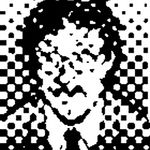 Adobe Community
Adobe Community
- Home
- Illustrator
- Discussions
- Re: How do I create two shapes with a shared borde...
- Re: How do I create two shapes with a shared borde...
Copy link to clipboard
Copied
I just started learning Illustrator so I set myself the challenge of a 2 colour triangle.
This is a red triangle with a yellow semi circle placed on a higher layer.
But with a future project in mind, I really wanted to create it like a patchwork - two shapes sharing a border. Like this picture, but with extra tweaking to get the edges to align.
Tutorials that I have watched so far only demonstrate overlapping shapes on different layers. Am I just thinking about this in the wrong way with my patchwork quilt concept or is there some tool/technique I have yet to discover?
 1 Correct answer
1 Correct answer
You could try Live Paint, you only need to draw a border once (can even be an invisible no stroke border), it does not have to be a closed object and use the Live Paint Bucket to fill the areas on both sides of the border.
https://helpx.adobe.com/illustrator/using/live-paint-groups.html
Explore related tutorials & articles
Copy link to clipboard
Copied
If you create two overlapping objects as in your first example, you can select them both an click Divide in the Pathfinder panel.
Copy link to clipboard
Copied
Mortimer,
In a case such as this, you can also:
1) Create the red triangle (as you have),
2) Create an open curved path that starts and ends exactly on top of the two bottom Anchor Points,
3) In the Object dropdown click Path>Divide Objects Below to divide the triangle in the two desired parts,
4) Recolour either new part.
Edit: Hi Ton, grey, cold, and windy here.
Copy link to clipboard
Copied
Hi Jacob, warm and mostly sunny over here.
Copy link to clipboard
Copied
Mortimer,
In your second image you have drawn two similar borders.
The key to the accurate (and easy) solution is to only draw one border, and then use it in one of multiple possible ways depending of the objects to share that border.
Copy link to clipboard
Copied
Thank you for the answers; I can see how they get my separate patches.
This image exemplifies my ultimate goal—a patchwork of about ten complicated shapes. I admit it is my inexperience, but I am still unsure of the best way to approach this task.
Copy link to clipboard
Copied
You could try Live Paint, you only need to draw a border once (can even be an invisible no stroke border), it does not have to be a closed object and use the Live Paint Bucket to fill the areas on both sides of the border.
https://helpx.adobe.com/illustrator/using/live-paint-groups.html
Copy link to clipboard
Copied
Thank you. That looks promising.
Copy link to clipboard
Copied
Mortimer,
In any case where you have a path like the triangle and a curved path and wish to have the border end at the corners of the triangle, it can be easier to fit the triangle to the curved path by moving the triangle by one corner Anchor Point to snap to the curved path and then rotating it round that corner Anchor Point so that the other corner Anchor Point snaps to the curve. After that you can use Divide.
You can see how to rotate as described here,
https://helpx.adobe.com/illustrator/using/rotating-reflecting-objects.html




